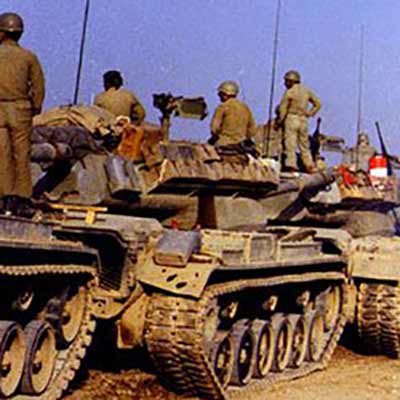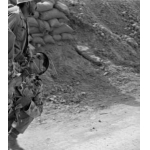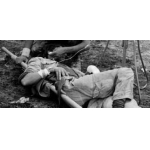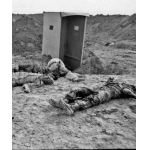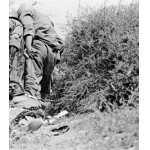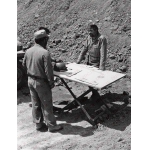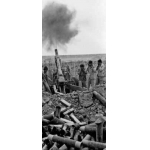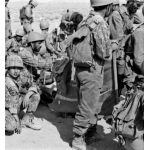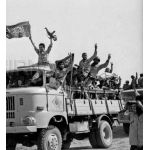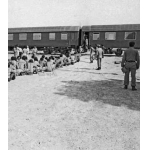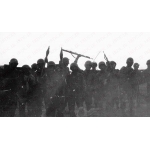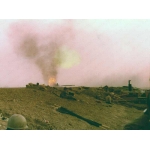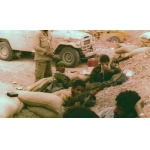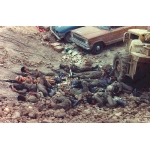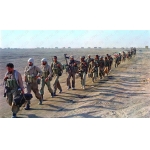Battles
Operation Beit al-Muqaddas
Leila Azadeh
523 Views
Operation Beit al-Muqaddas was one of the largest Iranian operations aimed at liberating areas occupied by the Iraqi army. It resulted in the liberation of 5038 square kilometers of occupied lands, including the cities of Khorramshahr, Hoveyzeh, Hamid military base, and the Ahvaz-Khorramshahr Road.
After the liberation of the areas west of the Karkheh River during the Operation Fath al-Mobin in 1982, the Iranian forces sought to liberate the western part of the Karun River i.e., the last area occupied by Iraq on the southern front, via launching the Operation Beit al-Muqaddas.[1] This operation aimed at defeating the Iraqi forces, the liberation of occupied lands west of the Karun River, and threatening Basra so that Iraq would accept paying the costs of the war. The liberation of Khorramshahr had strategic and political significance. Moreover, the operation aimed to save the cities of Ahvaz, Hamidieh, Susangerd, and the Ahvaz-Abadan Road [HR1] against Iraq’s artillery attacks, restore the international border and liberate the communication road between Ahvaz and Khorramshahr.[2]
Operation Beit al-Muqaddas had four stages.[3] Being surrounded by four natural barriers the area of the operation was bounded to the north by the Karkheh River, to the south by the Arvand River, to the east by the Karun River, and to the west by Hoor al-Hoveyzeh and the land of the region was continuous and rectangular.[4]
A key point of the operational organization was the close cooperation between the Islamic Revolutionary Guard Corps (IRGC), the Army, and the Jihad of Construction.[5]
The “Karbala Headquarters” with four other headquarters namely Quds, Fath, Nasr, and Fajr in addition to seven divisions and five independent brigades affiliated with the Army and IRGC controlled and directed the operation.[6] Ali Sayyad Shirazi from the Army and Mohsen Rezaei from the IRGC commanded the central Karbala Headquarters. The Quds Headquarters was led by Aziz Jafari from the IRGC and Sirous Lotfi from the Army. Gholamali Rashid and Masoud Monfared as the IRGC and Army forces respectively commanded the Fath Headquarters. At the same time, the Nasr Headquarters was led by Hassan Baqeri from the IRGC and Hussain Hasani-Saadi from the Army.[7] Jihad of Construction was responsible for constructing trenches, roads, bridges, and bunkers before, during, and after each stage of the operation.
The operation began at 6:30 AM on Friday, April 30, 1982, with the code-name "Ya Ali ibn Abi Talib (as)".[8]
Controlling the operation in the northern axis was assigned to the Quds Headquarters (by crossing the Karkheh River), the middle axis to the Fath Headquarters (by crossing the Karun River and advancing towards the Ahvaz-Khorramshahr Road), and the southern axis to the Nasr Headquarters (by crossing the Karun and advancing towards northern Khorramshahr).[9]
In the first phase of the operation, the units of the Quds Headquarters clashed with Iraqis forces and took control of their positions in the south of the Karkheh. The Fath Headquarters captured a bridgehead and reached the Ahvaz-Khorramshahr Road. Although the Nasr Headquarters crossed the river, due to poor coordination and the daylight, the operation was halted by a counterattack that jeopardized the left flank of the bridgehead. The Iraqis recaptured the breach point in the northern axis where the Quds Headquarters had gained control. In the Fath Headquarters’ operational area, due to the failure to link up the Nasr and Fath Headquarters, the Iraqi forces mounted heavy pressure to retake the bridgehead. However, the Iranian forces managed to retain the axis though the units of the Quds Headquarters retreated to their original positions.[10]
In the second phase of the operation, the forces of the Fath Headquarters reached the border road. The Nasr Headquarters was under heavy pressure from the Iraqis, but using the canal that marked the boundary line between the Fath and Nasr Headquarters, they resisted the Iraqi counterattacks. Eventually, the Iraqi forces withdrew from the west side of the road, and the Ahvaz-Khorramshahr Road was liberated. As a result, Iranian forces could reinforce their positions not only across the Karun River but also throughout areas leading to Ahvaz.[11]
The third phase of the operation began with the aim of complete defeat of the Iraqi forces and liberating Khorramshahr. The concentration of Iraqi forces in Khorramshahr and the exhaustion of Iranian troops made advancing towards the objectives difficult. Although in this phase the goals were not achieved, some Iraqi forces were destroyed.[12]
In the fourth phase of the operation, the forces of the Fath Headquarters reached the Khorramshahr police station, and the Fajr Headquarters captured the Pol-e Nou and advanced towards the Arvand River. Clearing the area and destroying the Iraqi forces, the units of the Nasr Headquarters advanced along the border and moved south towards the Khayyen. Despite strong resistance from the enemy, particularly at the Pol-e Nou, to keep their forces' rear secure the Iranian forces entered Khorramshahr from the western and northern gates, the same axis the Iraqis had used to enter the city, and liberated the city on May 24, 1982.[13]
The damage and casualties inflicted on Iraq in this operation were significant. 5400 square kilometers of Iranian territory were liberated. 16,000 Iraqi soldiers were killed or wounded, and 19,000 were taken prisoner. 50 vehicles, 5500 tanks and armored personnel carriers, dozens of artilleries, 53 aircraft, and 3 helicopters were destroyed during the operation. The victory of Operation Beit al-Muqaddas was owed to the sacrifices made by around 6000 martyrs and about 25,000 wounded.[14]
The liberation of Khorramshahr was the result of adopting unique tactics that the Iraqis had no preparation or capability to counter.[15] Iran's victory in Operation Beit al-Muqaddas and the liberation of Khorramshahr marked a strategic shift in the course of the war. The balance of power in the region changed, and therefore the United States sought to end the war without declaring either side as victorious. Furthermore, Saddam received massive amounts of support from his backers who tried to keep him strong and determined.[16]
On May 24, 1982, Imam Khomeini (ra) issued a congratulatory message expressing gratitude to the commanders of the armed forces, the Iranian warriors, and the Iranian people.[17]
Regarding the naming of Operation Beit al-Muqaddas, Mohsen Rezaei, the Commander-in-Chief of the IRGC at the time, said in a radio message: "We wanted to convey this message that we have no intention to invade any country. Our goal is to drive out the foreigners and mercenaries who have entered the Iranian territory, and our ultimate goal is the liberation of al-Quds and the House of God, which must be cleansed from the filth of international Zionism and imperialism".[18]
Numerous films and TV series have been produced about Khorramshahr and the operation to liberate it, including Harim-e Mehrvarzi, Fath-e Khorramshahr, Balami Be Suye Sahel, Kimia, Sarzamin-e Khorshid, Duel, Rooz-e Sevom, Khaak Sorkh, Qafasi Baray-e Parvaz, Dar Cheshm-e Baad, and Golha-ye Garmsiri. The Khorramshahr Liberation Theater Festival is also one of the thematic and longstanding theater festivals held annually, with various plays being performed about the subject.
[1] Operation Beit al-Muqaddas, Liberation of Khorramshahr, (Design, Execution, Results, Reflections, Reactions), Tehran: Markaz-e Motaleat and Tahqiqat Sepah Pasdaran Enqelab Eslami Iran, 1384, p. 14.
[2] Ibid., p. 18.
[3] Bakhtiari, Masud, Moin-Vaziri, Nosratollah, Artesh Jomhuri Eslami Iran dar Hasht Sal Defa Muqaddas (The Army of the Islamic Republic of Iran in the Eight Years of Sacred Defense), Vol. 4: Nabard Beyt al-Muqaddas, Azadsazi Khorramshahr, Tehran: Moavenat Tabliqat va Ravabet Omumi Sazman Aqidati Siasi Artesh Jomhuri Eslami Iran, 1373, Pp. 81–82.
[4] Dorudian, Muhammad, Tajziye va Tahlil Jang Iran va Iraq, Pishdar-amadi bar Yek Nazariye (Analysis of the Iran-Iraq War: An Introduction to a Theory), Tehran: Markaz Asnad va Tahqiqat Defa Muqaddas Sepah Pasdaran Enqelab Eslami, 1395, p. 292.
[5] Amaliyat Beit al-Muqaddas, Azadi Khorramshahr (Operation Beit al-Muqaddas, Liberation of Khorramshahr), p. 19.
[6] Jafari, Mojtaba, Atlas Nabardha Mandegar (Atlas of Enduring Battles), Tehran: Sure Sabz, Ch. 35, 1393, Pp. 76–77.
[7] Rashid, Mohsen, Atlas Hamase Khorramshahr (Atlas of the Epic of Khorramshahr), Tehran: Markaz Asnad va Tahqiqat Defa Muqaddas Sepah Pasdaran Enqelab Eslami, 1397, p. 116.
[8] Jafari, Mojtaba, Atlas Nabardha Mandegar (Atlas of Enduring Battles), Pp. 76–77.
[9] Pourjabbari, Pejman, Atlas Joghrafiya Hamasi 1: Khuzestan dar Jang (Geographical Atlas of Epic 1: Khuzestan in the War), Tehran: Sarir, 1389, p. 43.
[10] Dorudian, Muhammad, Tajziye va Tahlil Jang Iran va Iraq, Pishdar-amadi bar Yek Nazariye (Analysis of the Iran-Iraq War: An Introduction to a Theory), Pp. 298–299.
[11] Amaliyat Beit al-Muqaddas, Azadi Khorramshahr (Operation Beit al-Muqaddas, Liberation of Khorramshahr), Pp. 26–27.
[12] Dorudian, Muhammad, Tajziye va Tahlil Jang Iran va Iraq, Pishdar-amadi bar Yek Nazariye (Analysis of the Iran-Iraq War: An Introduction to a Theory), Pp. 300–301.
[13] Amaliyat Beit al-Muqaddas, Azadi Khorramshahr (Operation Beit al-Muqaddas, Liberation of Khorramshahr), p. 28.
[14] Alaei, Hussain, Tarikh Tahlili Jang Iran va Iraq (Analytical History of the Iran-Iraq War), Vol. 1, Tehran: Marz o Boom, 1395, p. 488.
[15] Dorudian, Muhammad, Seyri dar Jang Iran va Iraq, Vol. 2: Khorramshahr ta Faw (A Study of the Iran-Iraq War, Vol. 2: From Khorramshahr to Faw), Tehran, Markaz Motaleat va Tahqiqat Jang Sepah Pasdaran Enqelab Eslami, Ch. 5, 1378, p. 17.
[16] Velayati, Ali Akbar, Tarikh Siyasi Jang Tahmili (The Political History of the Imposed War), Tehran: Daftar Nashr Farhang Eslami, 1376, Pp. 114–117.
[17] Bakhtiari, Masud, Moin-Vaziri, Nosratollah, Artesh Jomhuri Eslami Iran dar Hasht Sal Defa Muqaddas (The Army of the Islamic Republic of Iran in the Eight Years of Sacred Defense), Vol. 4, Pp. 179–181.
[18] Rozshomar Jang Iran va Iraq, Ketab Nuzdahom: Azadsazi Khorramshahr, Payan Royaye Tajziye Iran (Chronology of the Iran-Iraq War, Book 19: Liberation of Khorramshahr, The End of the Dream of Iran’s Partition), p. 17.




